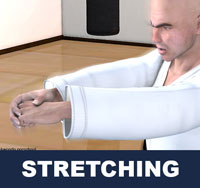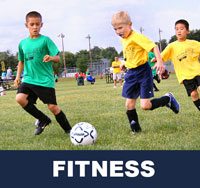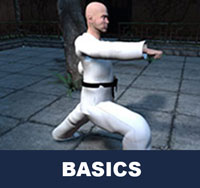Taekwondo 태권도Taekwondo Preschool
Promotion from one geup to the next can proceed rapidly in some schools, since schools often allow geup promotions every two, three, or four months. Students of geup rank learn the most basic techniques first, and then move on to more advanced techniques as they approach first dan. Many of the older and more traditional schools often take longer to allow students to test for higher ranks than newer, more contemporary schools, as they may not have the required testing intervals. View Taekwondo belt levels »

About Passive Stretching
Sports injuries are injuries that occur in athletic activities. They can result from acute trauma, or from overuse of a particular body part. Please see a certified specialist or doctor for sports injuries. Proper guidance and instructions are needed from a certified Master Instructor ( 사범님 sabeomnim ) to ensure safe training.
PNF stretching, or proprioceptive neuromuscular facilitation stretching, is a set of stretching techniques commonly used in clinical environments to enhance both active and passive range of motion with the ultimate goal being to optimize motor performance and rehabilitation. The literature regarding PNF has made the technique the optimal stretching method when the aim is to increase range of motion, especially in short-term changes. Generally an active PNF stretch involves a shortening contraction of the opposing muscle to place the target muscle on stretch. This is followed by an isometric contraction of the target muscle. PNF can be used to supplement daily stretching and is employed to make quick gains in range of motion to help athletes improve performance. Aside from being safe and time efficient, the dramatic gains in range of motion seen in a short period of time may also promote compliance with the exercise and rehabilitation program
History
In the early to mid 1900s physiologist Charles Sherrington popularized a model for neuromuscular facilitation and inhibition. This subsequently led Herman Kabat, a neurophysiologist, to develop the clinical PNF stretching technique using natural movement patterns. He knew of the myotatic stretch reflex which causes a muscle to contract when lengthened too quickly, and of the inverse stretch reflex, which causes a muscle to relax when its tendon is pulled with too much force. He believed combinations of movement would be better than the traditional moving of one joint at a time. Initial PNF techniques were used to aid the rehabilitation of clients with spasticity and weakness by facilitating muscle elongation. This is theorized to be accomplished through enhanced inhibitory mechanisms affecting the spastic muscle, and improving the muscle strength through improved excitation mechanisms in the weakened muscle.
Kabat started an institute in Washington, DC and by 1951 had two offices in California as well. His assistants Margaret Knott and Dorothy Voss in California applied PNF to all types of therapeutic exercise and began presenting the techniques in workshops in 1952. During the 1960s, the physical therapy departments of several universities began offering courses in PNF and by the late 1970s PNF stretching began to be used by athletes and other healthy people for more flexibility and range of motion. Terms about muscle contraction are commonly used when discussing PNF: Eccentric Isotonic contraction is when the muscle lengthens while resisting an applied force, and isometric muscle contraction is when the muscle remains the same length while contracting
Techniques
The patterns of movement associated with PNF are composed of multijoint, multiplanar, diagonal, and rotational movements of the extremities, trunk & neck. There are 2 pairs of foundational movements for the upper extremities; UE D1 flexion & extension, UE D2 flexion & extension. There are also 2 pairs of foundational movements for the lower extremities; LE D1 flexion & extension, LE D2 flexion & extension. Various PNF stretching techniques based on Kabat’s concept are: Hold Relax, Contract Relax, and Contract Relax Antagonist Contract (CRAC) etc.
Contract Relax: Passive placement of the restricted muscle into a position of stretch followed by an isometric contraction of the restricted muscle. Most isometric contractions in PNF stretching techniques should be held for a minimum of 3 seconds at a sub maximal effort (20-50% of maximal effort) to avoid muscle fatigue and injury. After the contraction period the patient is instructed to relax the restricted muscle that was just contracting and activate the opposing muscle to move the limb into a greater position of stretch. Through Golgi tendon organ, the tight muscle is relaxed, and allowed to lengthen.
Hold Relax: Very similar to the Contract Relax technique. This is utilized when the agonist is too weak to activate properly. The patient's restricted muscle is put in a position of stretch followed by an isometric contraction of the restricted muscle. After the allotted time the restricted muscle is passively moved to a position of greater stretch. Contraction times and efforts will remain the same as the Contract Relax technique. This technique utilizes the autogenic inhibition, which relaxes a muscle after a sustained contraction has been applied to it for longer than 6 seconds.
Contract Relax Antagonist (Agonist) Contract (CRAC) is performed by-passive stretch of agonist muscle, followed by maximum isometric contraction of agonist muscle and passive stretch of agonist muscle again. After that, maximum isotonic contraction of antagonist muscle is performed. This technique used autogenic and reciprocal inhibition.
Rhythmic Initiation: Developed to help patients with Parkinsons overcome their rigidity. Begins with the therapist moving the patient through the desired movement using passive range of motion, followed by active-assistive, active-resisted range of motion, and finally active range of motion.
Rhythmic Stabilization: and Alternating Isometrics are very similar in that they both encourage stability of the trunk, hip, and shoulder girdle. With this technique, the patient holds a weight-bearing position while the therapist applies manual resistance. No motion should occur from the patient. The patient should simply resist the therapist's movements. For example, the patient can be in a sitting, kneeling, half-kneeling, or standing position when the therapist applies manual resistance to the shoulders. Usually, the therapist applies simultaneous resistance to the anterior left shoulder and posterior right shoulder for 2–3 seconds before switching the resistance to the posterior left shoulder and the anterior right shoulder. The therapist's movements should be smooth, fluid, and continuous. In AI, resistance is applied on the same side of the joint. In RS, resistance is applied on opposite sides of the joint. Note this is not a stretching technique, but instead a technique used to strengthen joint musculature and improve proprioception.
Slow reversals: This technique is based on Sherrington's principle of successive induction, i.e. that immediately after the flexor reflex is elicited the excitability of the extensor reflex is increased.This technique is used to strengthen and buildup endurance of weaker muscles and develop co-ordination and establish the normal reversal of antagonistic muscles in the performance of movement.

Related Articles
Physical fitness is a general state of health and well-being or specifically the ability to perform aspects of sports or occupations. It is a set of attributes or characteristics that people have or achieve that relates to the ability to perform physical activity. View Physical Fitness »
- Stretch - Form of physical exercise in which a specific muscle or tendon (or muscle group) is deliberately flexed or stretched in order to improve the muscle's felt elasticity and achieve comfortable muscle tone. The result is a feeling of increased muscle control, flexibility and range of motion.
- Flexibility - Refers to the absolute range of movement in a joint or series of joints, and length in muscles that cross the joints. Flexibility in some joints can be increased to a certain degree by exercise, with stretching a common exercise component to maintain or improve flexibility.
- Endurance - Ability of a practitioner to exert itself and remain active for a long period of time, as well as its ability to resist, withstand, recover from, and have immunity to trauma, wounds, or fatigue.
- Balance - Ability to maintain the line of gravity (vertical line from centre of mass) of a body within the base of support with minimal postural sway. Sway is the horizontal movement of the centre of gravity even when a person is standing still.
- Agility - Or nimbleness is the ability to change the body's position efficiently, and requires the integration of isolated movement skills using a combination of balance, coordination, speed, reflexes, strength, and endurance.

Taekwondo Basics
Here is where you can learn more about Taekwondo 태권도. Knowing the fundamental basics is very important for your learning path as you build your skills and knowledge. There are certain rules that need to be followed to show respect to the master ( 사범님 sabeomnim ), the instructors ( 교사님 gyosannim ), other practitioners and to the martial arts. They vary between schools but many have similar rules and guidelines. For more information View Taekwondo Basics »
Please follow the guidance of a certified Master Instructor or trainer when doing sports related activities. The article provided on this page is information that is widely available on Wikipedia articles "Stretching", "Static Stretching", "Dynamic Stretching", "Ballistic Stretching". Risk of injury can be reduced by completing an effective warm up consisting of a heart raiser to get your pulse up, followed by sport specific dynamic stretches (stretches whilst moving).
RESOURCES
This article uses material from the Wikipedia article "PNF Stretching", which is released under the Creative Commons Attribution-Share-Alike License 3.0.






















